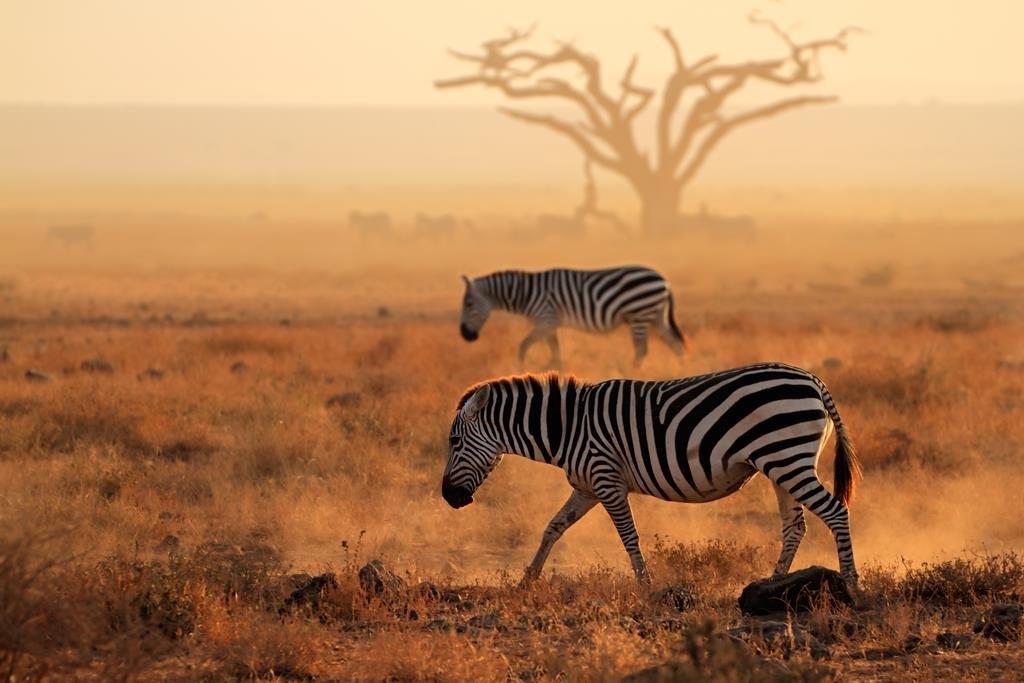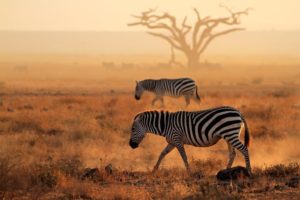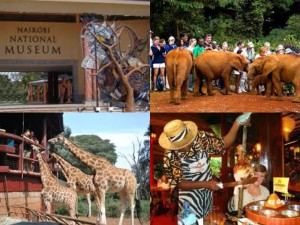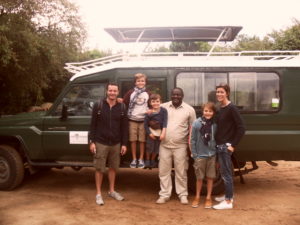Laikipia
To the north-east of the Great Rift Valley, and north-west of snow-capped Mount Kenya. Between Mount Kenya and the northern deserts, these high rangelands spread out between north-flowing streams and rivers, which flow throughout most of the year into the Ewaso Nyiro, northern Kenya’s greatest river.
Formerly a patchwork of huge ranches, and still an important livestock district, Laikipia is now where some of Kenya’s most encouraging conservation success stories are unfolding. The environment here is managed to protect the wildlife, to promote a personal and small-scale approach to adventurous and often luxurious safari tourism, and to generate an income for the local Samburu and Ilaikipiak and Mokogodo Maasai communities.
Laikipia wildlife
Laikipia harbours a wealth of endangered species, including roughly half of Kenya’s 600-odd black rhinos. As browsers rather than grazers, black rhinos do well in the same environment as cattle as long as the bush isn’t cleared. Also on the increase in Laikipia are wild dogs, with several packs here and good chances of seeing them: Laikipia is now their second most important range in Africa. Spotting Grevy’s zebras –the handsome, radar-eared, fine-striped species – is almost a certainty, as a quarter of Africa’s remaining population lives in Laikipia. You can find most of Kenya’s more common wildlife in Laikipia, too, as well as more than 2,000 elephants, which migrate between the slopes of Mount Kenya, the Laikipia safari conservancies and the Samburu region.
The animals in Laikipia, especially the rarer species, tend to be closely managed, with predators often radio-collared in order to track them, and wildlife rangers monitoring individual rhinos, keeping an eye on them day and night. While this might strike you as unnatural, it’s hard to argue with the results – better understanding of animal movements, behaviour and population trends, and even occasional opportunities for visitors to be directly involved in wildlife conservation activities.
Visiting Laikipia on safari
There are three airstrips for scheduled safari flights into Laikipia: Nanyuki (the most important), Loisaba and Lewa Downs. Transfers from the airstrips to most of our lodges and camps can be done in under an hour, but in the case of longer transfers, or for particular itineraries where scheduled flights are less convenient, we may suggest chartering a plane to take you direct to the airstrip of your camp or lodge. Also we can propose 4X4 vehicles for a road safari to Laikipia.
Safaris at Ol Pejeta Conservancy
The busiest of the Laikipia wildlife sanctuaries, its eastern border just a few miles from the highland town of Nanyuki. With its rolling short-grass plains with thickets of acacia woodland, the 365km² conservancy has big concentrations of mammals, including all the native plains game, especially black rhinos and African wild dogs. Ol Pejeta’s biggest project of recent years is its northern white rhino breeding programme. The northern white rhino is a distinct sub-species of white rhino, and three of the last six individuals in the world live here in a closely guarded 30km² sanctuary. It is hoped they will form the nucleus of a breeding group from which Ol Pejeta can select for northern traits and thus steadily preserve the characteristics of the northern sub-species. Most of the rhinos at Ol Pejeta have had their horns trimmed to reduce their value to poachers
Ol Pejeta Chimpanzee Sanctuary
Ol Pejeta’s 1km² chimpanzee sanctuary is a welfare refuge for more than 40 confiscated pet chimps and orphans of the bush meat trade from several central African countries, notably Burundi. They live in two troops, separated by the Ewaso Nyiro River, and lead lives of relative freedom in their extensive, fenced enclosures, despite being prevented from breeding and being fed market fruit and vegetables rather than foraging for food. Visits, to the outside of the fence, are organised twice a day.
Safaris at Lewa Wildlife Conservancy
The efficiently managed Lewa Wildlife Conservancy protects more than 65 black and more than 50 white rhinos as well as around 350 Grevy’s zebra and a population of the rare sitatunga, a semi-aquatic antelope more usually seen in central Africa. One of the oldest of the Laikipia conservancies, Lewa includes the rolling grasslands of Lewa Downs, and a mixture of riverine woodland, scrubby bush and open plains – an excellent range of environments for a very wide variety of game.
Safaris at Borana Ranch
Bordering Lewa Wildlife Conservancy to the west, the 142km² Borana Ranch is a former settler farm that has evolved into a model of integrated sheep and cattle herding, wildlife management and adventure-safari tourism. Borana is home to some 300 elephants (including 12 radio-collared matriarchs), four prides of lions, hyenas and cheetahs and a maximum of 32 visiting humans on safari. If you’re one of the latter, you can see the stunning landscapes of the ranch from a 4×4, on foot, on horseback (they have a stable of 26 horses suitable for experienced riders, plus other ponies for novices and children) or on a mountain bike. The most recent arrivals at Borana are 19 black rhinos, translocated here in 2013 from neighbouring Lewa, with which Borana has recently combined territories by eliminating the fence between the ranches.
Safaris at Solio Ranch
The privately owned Solio Game Ranch lies in the grasslands between Mount Kenya and the Aberdare Range. This landholding, once on a key migration route for elephants, and later a cereal and cattle ranch, was a pioneer in saving the Kenyan black rhino from extinction, breeding them here for subsequent translocation into Kenya’s national parks and other reserves. More than 70 indigenous black rhino now live here, alongside more than 140 white rhinos. While the ranch has been here for decades, Solio Lodge is a modern addition – a slick and spectacular hotel-style set up of six huge cottages with panoramic windows, luxuriously appointed bathrooms and open fireplaces. One of the cottages is family- sized and faces a small waterhole. As well as game drives, with virtually guaranteed rhino sightings, you can walk, cycle or ride among the wildlife (the lodge has its own stables) and do trips into the nearby Aberdare and Mount Kenya national parks.
Safaris at Sosian Ranch
The 100km² Sosian Ranch is another of Laikipia’s mixed ranching and conservation areas, where they manage a herd of 700 Boran cattle alongside a wide range of wildlife, including large herds of elephants, reticulated giraffes and hippos and good numbers of predators, including wild dogs. The ranch works with its neighbour, Mpala Ranch, on predator research, particularly focusing on the wild dog packs that roam Laikipia. At Sosian, wild dogs can often be seen relatively easily, using radio-tracking equipment to track the collared individuals. The main Sosian pack denned on the ranch at the end of 2012 and we recently had reports of the pups being seen for the first time.
Safaris at Il Ngwesi Conservancy
Preeminent among the traditional pastoral and wildife areas north of Lewa is the Il Ngwesi Conservancy, a 145km² group ranch between the Mukogodo Escarpment and the Ngare Ndare River. It’s home to the 6000-strong Laikipiak Maasai community, who traditionally herd their livestock through this wild bush country. With the building of Il Ngwesi Eco-Lodge in 1996, they now combine their pastoral lifestyle with income generated by tourism and conservation. When it opened, Il Ngwesi Eco-Lodge was Kenya’s first community-run safari lodge. Operated on strict environmental principles, this delightful, six-cottage property, set on a stony, bush-covered hilltop, is entirely staffed and managed by people from the local community. Short game drives are available as morning and evening (and after-dark) activities but the main thrill here is walking through the bush and along the dry river beds, accompanied by guides and armed rangers.
Safaris at Laikipia Wilderness on Ol Doinyo Lemboro Ranch
With the meandering Ewaso Narok flowing along its northern boundary, Ol Doinyo Lemboro Ranch covers more than 80km² of rough and bushy grazing land, pimpled with rocky kopjes. The largely roadless ranch is now mostly devoted to wildlife conservation and open to visitors who stay at the single, small, environmentally friendly Laikipia Wilderness safari camp. The wildlife here is diverse: it’s good leopard country and has plentiful grazers. The region swarms with dik-diks and these form the main diet of the two wild dog packs that roam the area and are a highlight for visitors.




